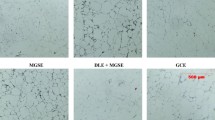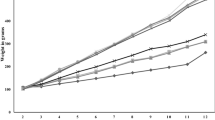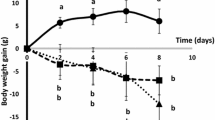Abstract
Previous studies have shown that the mixture of extracts of grape pomace and omija (GO) improved oxidative stress and obesity in mice. This study first investigated the dose–response effects of GO on oxidative stress and fat-pad mass. Male C57BL/KsJ-db/db mice were fed the following three experimental diets for 7 weeks: a normal control, high-dose grape pomace plus omija (HGO; 0.5% grape pomace plus 0.05% omija fruit, w/w), and low-dose grape pomace plus omija (LGO; 0.3% grape pomace plus 0.05% omija fruit, w/w). The LGO significantly decreased white adipose tissues weights, as well as ameliorated the plasma lipid profiles. The antioxidant effects of LGO led to a significant decrease in the erythrocytic H2O2 and thiobarbituric acid-reactive substance levels, while LGO increased erythrocytic antioxidant activities. These results suggest that LGO is more effective than HGO in lowering oxidative stress and body fat mass in db/db mice.
Similar content being viewed by others
Avoid common mistakes on your manuscript.
Introduction
Obesity characterises elevated plasma free fatty acid (FFA) level and fat-pad mass, which are generally seen in patients with type 2 diabetes [1]. Obesity, abdominal adiposity, and large waist circumference are good predictors of diabetes [2]. In addition, excess lipids as well as elevated FFA and blood glucose levels result in the increased production of oxidants by the mitochondria [2]. In diabetes animals, hyperglycemia depletes the natural antioxidants and facilitates the production of free radicals, resulting in oxidative stress [3]. Other factors such as homocysteine, insulin resistance, and aging may also contribute to oxidative stress [3].
Plant-derived polyphenols have been shown to have many beneficial effects on aging, oxidative stress, obesity, and metabolic diseases [4, 5]. Many widely consumed foods such as tea, juices, grape, blueberry, cocoa, and apple contain much polyphenols [4]. Grapes or their by-products have been considered a representative of polyphenol-rich plants, which have been reported to reduce obesity and prevent metabolic diseases by increasing the antioxidant properties or by suppressing inflammation [5]. In previous our studies, mixture of grape pomace and omija reduced obesity, metabolic diseases, oxidant, and inflammation [6,7,8]. Omija (Schisandra chinensis) is also a polyphenol-containing plant, which is commonly consumed as tea or juice.
Studies on polyphenol-containing plant extracts have been performed more in diet-induced obese mice than in type 2 diabetic mice. Most of the studies in diabetic mice reported about hyperglycemia than about antioxidant activity. We published that the mixture of extracts of grape pomace and omija (GO) improved oxidative stress and obesity, and/or compared to grape pomace alone, in diet-induced obese or db/db mice [6,7,8]. Accordingly, this study first investigated the dose–response effects of GO on oxidative stress and fat-pad mass in db/db mice.
Materials and methods
Extract preparation
Grape pomace and omija fruit extracts were prepared by the method of Cho et al. [7]. Grape pomace ethanol extract typically contains resveratrol, flavonoid, polyphenol and omija fruit ethanol extract typically contains schizandrin, flavonoid, polyphenol [8].
Animals and diet
C57BL/KsJ-db/db mice (4-week-old, Jackson Laboratory, Bar Harbor, ME, USA) were fed the following three experimental diets for 7 weeks (n = 10 per group): a normal control, high-dose grape pomace plus omija (HGO; 0.5% grape pomace plus 0.05% omija fruit ethanol extract, w/w), and low-dose grape pomace plus omija (LGO; 0.3% grape pomace plus 0.05% omija fruit ethanol extract, w/w). The experimental diet composition is shown in Table 1. This animal study protocol was approved by the Ethics Committee for animal studies at Kyungpook National University, Republic of Korea.
Sampling
The procedures for sacrificing mice and separating samples in whole blood followed by Cho et al. [6]. Removed organs were weighed and stored at −70 °C. Hepatic enzyme sources were prepared by Cho et al. [8].
Plasma lipid level
Commercial kits were used for determining plasma lipid levels: total cholesterol, triglyceride, high-density lipoprotein (HDL) cholesterol (Asan Pharmaceutical Co., Ltd.,), FFA (Wako Chemicals, Richmond, VA, USA) and apolipoprotein B (Eiken, Tokyo, Japan).
Plasma ghrelin level
Analysing for plasma ghrelin concentration, multiplex kit (Bio-Rad, Hercules, CA, USA), Luminex 200 Labmap system (Luminex, Austin, TX, USA) and Bio-Plex Manager software version 4.1.1 (Bio-Rad).
Antioxidant enzyme activity, and H2O2 and lipid peroxidation assay
Erythrocyte, plasma, and hepatic antioxidant enzyme activity, and H2O2 and thiobarbituric acid-reactive substance (TBARS) levels were measured by the method of Cho et al. [6].
Statistical analysis
Data were subjected to analysis using Statistical Package for Social Science (SPSS, Inc. Chicago, IL, USA). Significant differences among the groups were determined using one-way ANOVA followed by Duncan test. Results were considered statistically significant when p < 0.05.
Results and discussion
Type 2 diabetes characterises serious complications. Excess body fat and peroxides aggravate type 2 diabetes and various complications [9]. A healthy diet or dietary supplement is essential for preventing diabetes and its related complications. Our previous studies showed that the extract of grape pomace combined with omija (GO) ameliorated hyperglycemia and adiposity in db/db mice [10]. Then this present study further show that LGO is more effective than HGO in exerting antioxidant activity and decreasing body fat mass in db/db mice. In previous our study, low-dose-resveratrol had more benefits than high-dose-resveratrol [11]. That study referred to evidence that high-dose-polyphenols can have pro-oxidant capacity, and as a result, promote obesity and metabolic disease [11]. The results of this study and previous study were same, low-dose was more effective than high-dose, though experiment mice models were different [11].
Many plants extracts and products have been shown to suppress appetite, induce body fat loss, and reduce waist circumference [12]. Grape extract was reported to reduce the energy intake in overweight subjects [13]. In this study, HGO and LGO significantly suppressed food and energy intake, and the mesenteric and interscapular WAT weights compared to control, which was correlated with significantly decreased plasma ghrelin concentrations compared to control (Fig. 1). LGO also significantly lowered subcutaneous and total WAT weights by 15 and 17%, respectively, compared to control (Fig. 1). Ghrelin can stimulate appetite and promote increased food intake, and it is considered to participate in the body fat mass regulation [14]. Our previous studies have shown that GO reduces WAT weight and improves plasma lipid levels in obese and db/db mice [7, 8]. The present study showed that LGO was more effective than HGO. Both HGO and LGO supplements significantly suppressed total cholesterol, FFA, and apolipoprotein B levels in plasma compared to control (Table 2). Moreover, LGO, when compared with control, significantly lowered triglyceride (34%), non-HDL cholesterol (25%), and atherogenic index (21%) levels in plasma, whereas LGO significantly increased the plasma HDL cholesterol and HTR [(HDL-C/Total-C) × 100] levels by 16 and 17%, respectively, compared to control (Table 2). LGO not only ameliorated plasma lipid profiles, but also decreased the WATs weights, whereas it significantly increased interscapular BAT weight by 28% compared to control (Table 2, Fig. 1).
Effects of HGO or LGO on body weight, adipose tissue weights, food intake, and plasma ghrelin in db/db mice. C57BL/KsJ-db/db mice were fed experimental diets for 7 weeks (n = 10/group). Body weight and food intake were measured weekly, and plasma ghrelin level was measured using a multiplex kit. (A) Body weight; (B) adipose tissue weights; (C) food intake; (D) energy intake; (E) plasma ghrelin; (F) body weight gain, and (G) food efficiency ratio. (A–G) Data are represented as the mean ± SE (n = 10). a,bThe means not sharing a common letter differ significantly among the groups at p < 0.05. HGO, high-dose grape pomace plus omija (0.5% grape pomace plus 0.05% omija fruit ethanol extract, w/w); LGO, low-dose grape pomace plus omija (0.3% grape pomace plus 0.05% omija fruit ethanol extract, w/w)
Antioxidants in plants have been reported to suppress oxidation, free radical, reactive species and peroxides, and prevent the development and progression of diabetes complications [10]. As mentioned in the materials and methods, grape and omija used in this study contain various antioxidant compounds, such as polyphenols including flavonoids. Grape is a representative polyphenol-rich plant; omija also contains polyphenols, and the major compound is schizandrin. When comparing the antioxidant capacity of GOs, both HGO and LGO significantly suppressed oxidative stress (Figs. 2, 3), which was elevated in diabetic animals [3]. Moreover, LGO was more effective against erythrocyte oxidative stress than HGO, by significantly reducing the erythrocyte peroxides, TBARS and H2O2 levels by 38 and 8%, respectively, compared to control (Fig. 2). LGO may prevent oxidation in erythrocyte by significantly activating the antioxidant enzymes such as SOD (26%), catalase (13%), GSH-Px (20%), and paraoxonase (52%) than control (Fig. 2). SOD catalyzes the dismutation of superoxide radicals (O ·−2 ) to H2O2. The H2O2 can then be converted to H2O by catalases in the peroxisomes or be involved in the oxidization of GSH to GSSG by GSH-Px in the cytosol [15]. Paraoxonase, a HDL-associated enzyme, also lowers vascular oxidative stress by destroying not only the lipid peroxides, but also H2O2 [16]. Although the LGO supplement was more effective as a blood antioxidant than the HGO, when compared to the control, the HGO supplement significantly increased the plasma paraoxonase activity by 22%, whereas it significantly decreased the H2O2 level by 10% (Fig. 2). The hepatic antioxidant capacities of both low- and high-dose GO seem to be similar. Unlike erythrocyte enzyme activity, the hepatic antioxidant enzyme (catalase, GSH-Px, and GR) activities of HGO and LGO groups were significantly lower owing to the significantly decreased hepatic H2O2 levels of those groups compared to control (Fig. 3). In previous study, the HGO lowered GSH-Px and GR activities along with decrease in peroxides levels [6].
Effects of HGO or LGO on antioxidant enzyme activities and peroxide levels in the blood of db/db mice. The procedures for separating sources of antioxidant enzyme and peroxide in whole blood, and measuring antioxidant enzyme activities and peroxide levels followed by Cho et al. [6]. (A) Erythrocyte superoxide dismutase (SOD); (B) erythrocyte catalase; (C) erythrocyte glutathione peroxidase (GSH-Px); (D) plasma paraoxonase; (E) erythrocyte H2O2; and (F) erythrocyte thiobarbituric acid-reactive substance (TBARS). (A–F) Data are represented as the mean ± SE (n = 10). a,b,cMeans not sharing a common letter differ significantly among the groups at p < 0.05. HGO, high-dose grape pomace plus omija (0.5% grape pomace plus 0.05% omija fruit ethanol extract, w/w); LGO, low-dose grape pomace plus omija (0.3% grape pomace plus 0.05% omija fruit ethanol extract, w/w); Hb, hemoglobin
Effects of HGO or LGO on the antioxidant enzyme activities and H2O2 level in the liver of db/db mice. Hepatic antioxidant enzyme and H2O2 sources were prepared by Cho et al. [8]. Hepatic antioxidant enzyme activities and H2O2 level were measured by the method of Cho et al. [6]. (A) Hepatic superoxide dismutase (SOD); (B) hepatic catalase; (C) hepatic glutathione peroxidase (GSH-Px); (D) hepatic glutathione reductase (GR); (E) hepatic paraoxonase; and (F) hepatic H2O2. (A–F) Data are represented as the mean ± SE (n = 10). a,bMeans not sharing a common letter differ significantly among the groups at p < 0.05. HGO, high-dose grape pomace plus omija (0.5% grape pomace plus 0.05% omija fruit ethanol extract, w/w); LGO, low-dose grape pomace plus omija (0.3% grape pomace plus 0.05% omija fruit ethanol extract, w/w)
The present study shows that LGO is more effective than HGO in lowering the oxidative stress and body fat mass in db/db mice. These findings may provide useful data for determining the dose of combined plants extracts in future studies.
References
Boden G, Shulman GI. Free fatty acids in obesity and type 2 diabetes: defining their role in the development of insulin resistance and beta-cell dysfunction. Eur. J. Clin. Invest. 32: 14–23 (2002)
Chan JM, Rimm EB, Colditz GA, Stampfer MJ, Willett WC. Obesity, fat distribution, and weight gain as risk factors for clinical diabetes in men. Diabetes Care 17: 961–969 (1994)
Penckofer S, Schwertz D, Florczak K. Oxidative stress and cardiovascular disease in type 2 diabetes: the role of antioxidants and pro-oxidants. J. Cardiovasc. Nurs. 16: 68–85 (2002)
Uysal U, Seremet S, Lamping JW, Adams JM, Liu DY, Swerdlow RH, Aires DJ. Consumption of polyphenol plants may slow aging and associated diseases. Curr. Pharm. Des. 19: 6094–6111 (2013)
Chuang CC, McIntosh MK. Potential mechanisms by which polyphenol-rich grapes prevent obesity-mediated inflammation and metabolic diseases. Annu. Rev. Nutr. 31: 155–176 (2011)
Cho SJ, Jung UJ, Kim HJ, Kim YJ, Han Y, Moon BS, Park YB, Choi MS. Mixture of Ethanol Extract of Grape Pomade and Omija Fruit Prevents Hyperglycemia and Alleviates Oxidative Stress in Mice Fed an Obesogenic Diet. J. Diabetes Metab. 6: 562 (2015)
Cho SJ, Jung UJ, Park HJ, Kim HJ, Park YB, Kim SR, Choi MS. Combined ethanol extract of grape pomace and omija fruit ameliorates adipogenesis, hepatic steatosis, and inflammation in diet-induced obese mice. Evid. Based Complement. Alternat. Med. 2013: 212139 (2013)
Cho SJ, Park HJ, Jung UJ, Kim HJ, Moon BS, Choi MS. The beneficial effects of combined grape pomace and omija fruit extracts on hyperglycemia, adiposity and hepatic steatosis in db/db mice: a comparison with major index compounds. Int. J. Mol. Sci. 15: 17778–17789 (2014)
Murillo AG, Fernandez ML. Potential of Dietary Non-Provitamin A Carotenoids in the Prevention and Treatment of Diabetic Microvascular Complications. Adv. Nutr. 7: 14–24 (2016)
Cho SJ, Jung UJ, Kim HJ, Ryu R, Ryoo JY, Moon BS, Choi MS. Effects of the Combined Extracts of Grape Pomace and Omija Fruit on Hyperglycemia and Adiposity in Type 2 Diabetic Mice. Prev. Nutr. Food Sci. 20: 94–101 (2015)
Cho SJ, Jung UJ, Choi MS. Differential effects of low-dose resveratrol on adiposity and hepatic steatosis in diet-induced obese mice. Br. J. Nutr. 108: 2166–2175 (2012)
Gooda Sahib N, Saari N, Ismail A, Khatib A, Mahomoodally F, Abdul Hamid A. Plants’ metabolites as potential antiobesity agents. Scientific World Journal 2012: 436039 (2012)
Vogels N, Nijs IM, Westerterp-Plantenga MS. The effect of grape-seed extract on 24 h energy intake in humans. Eur. J. Clin. Nutr. 58: 667–673 (2004)
Cummings DE, Shannon MH. Roles for ghrelin in the regulation of appetite and body weight. Arch. Surg. 138: 389–396 (2003)
Mittler R. Oxidative stress, antioxidants and stress tolerance. Trends Plant Sci. 7: 405–410 (2002)
Aviram M, Rosenblat M, Bisgaier CL, Newton RS, Primo-Parmo SL, La Du BN. Paraoxonase inhibits high-density lipoprotein oxidation and preserves its functions. A possible peroxidative role for paraoxonase. J. Clin. Invest. 101: 1581–1590 (1998)
Acknowledgements
This work was supported by Kyungpook National University Bokhyeon Research Fund (2015), and by the National Research Foundation of Korea (NRF) grant funded by the Korea government (MSIP) (2015R1A5A6001906, 2012M3A9C4048818, 2016R1C1B1014846).
Author information
Authors and Affiliations
Corresponding author
Ethics declarations
Conflict of interest
The authors declare that they have no conflict of interest.
Rights and permissions
About this article
Cite this article
Cho, SJ., Kim, HJ., Choi, JY. et al. Low-dose grape pomace and omija fruit extract is more effective than high-dose in lowering oxidative stress and fat-pad mass in db/db mice. Food Sci Biotechnol 26, 1709–1714 (2017). https://doi.org/10.1007/s10068-017-0227-7
Received:
Revised:
Accepted:
Published:
Issue Date:
DOI: https://doi.org/10.1007/s10068-017-0227-7







